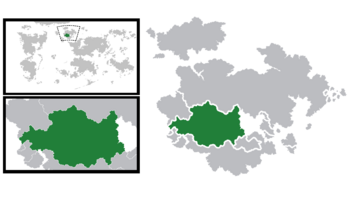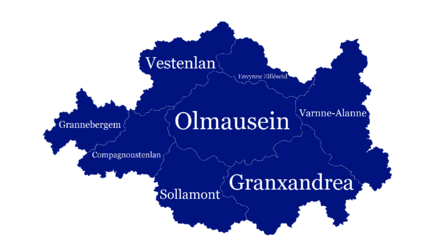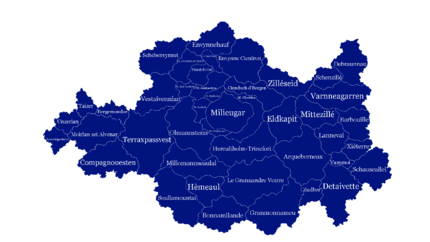Rousein: Difference between revisions
Mendozzau69 (talk | contribs) |
Mendozzau69 (talk | contribs) |
||
| Line 192: | Line 192: | ||
==Kingdom of Nou-Roieunséne== | ==Kingdom of Nou-Roieunséne== | ||
After the Great Flight, [[Galtier the Colonizer]] proclaimed himself a king, and colonies of former Roieunséne under Callais Monarchy became an independent entity. His seat and the center of the new kingdom were located in today's [[Compaugnoesten]], on the southwestern coast of today's Rousein where he built himself a fortress. This kingdom as a whole consisted of today's coastal [[Compagnouesten]], coastal [[Lecorriporteim]], coastal [[Debraunnau]], coastal [[Barbouille]], coastal [[Xièterre]], and the most southern part of the coast of Schauscallei. Galtier already knew at that time that nearby lands were inhabited by native [[Alenners]]. Throughout history, native Alenners will blend with Roieunsénais forming the Rouseinisch language and the Rouseiner ethnic and cultural identity. Although some of them will be enslaved and slain. Galtier eventually died in 773 at the age of 59. His remains have survived and been found and are enshrined in [[Ruheingudernstag]] (meaning the Greatest Resting Place) in the capital city of [[Milieugar]]. We also know from the analysis of his remains that he died from a neoplasm (tumor). His successor [[Galtier II]] took the reigns and ruled Nou-Roieunséne for 22 years even though we don't know much about him. There's no evidence that Galtier II and Galtier the Colonizer were related and his remains have never been found. Some Rouseiner historians say that he didn't hold any real power at all but the council comprised of six maires (mayors). He supposedly died in 795 and his alleged son Levier took his place. [[Levier the | After the Great Flight, [[Galtier the Colonizer]] proclaimed himself a king, and colonies of former Roieunséne under Callais Monarchy became an independent entity. His seat and the center of the new kingdom were located in today's [[Compaugnoesten]], on the southwestern coast of today's Rousein where he built himself a fortress. This kingdom as a whole consisted of today's coastal [[Compagnouesten]], coastal [[Lecorriporteim]], coastal [[Debraunnau]], coastal [[Barbouille]], coastal [[Xièterre]], and the most southern part of the coast of Schauscallei. Galtier already knew at that time that nearby lands were inhabited by native [[Alenners]]. Throughout history, native Alenners will blend with Roieunsénais forming the Rouseinisch language and the Rouseiner ethnic and cultural identity. Although some of them will be enslaved and slain. Galtier eventually died in 773 at the age of 59. His remains have survived and been found and are enshrined in [[Ruheingudernstag]] (meaning the Greatest Resting Place) in the capital city of [[Milieugar]]. We also know from the analysis of his remains that he died from a neoplasm (tumor). His successor [[Galtier II]] took the reigns and ruled Nou-Roieunséne for 22 years even though we don't know much about him. There's no evidence that Galtier II and Galtier the Colonizer were related and his remains have never been found. Some Rouseiner historians say that he didn't hold any real power at all but the council comprised of six maires (mayors). He supposedly died in 795 and his alleged son Levier took his place. [[Levier the Silver]] was much better documented than his alleged father and is generally respected by Rouseiner historians as an energetic ruler who significantly strengthened the state and expanded its territory. His accomplishments include significant economic development due to an expansion in trade and the introduction of silver mining in today's Moirlan zet Alvenar although he allegedly enslaved over 2,000 natives comprised of Alenners, Galavarians, and even Lisennisans. He ruled from 795 and died in 842 at the age of 70. His remains have also survived and are enshrined in Ruheingudernstag. He died of natural causes. There's no evidence that he was related to Galtier the Colonizer either. | ||
[[Category:Saurth]] | [[Category:Saurth]] | ||
Revision as of 16:51, 9 December 2023
Jarldom of Rousein Jarldømmé de Rousein | |
|---|---|
| Motto: Vur Rousein, vilje donnegi ma Liv! For Rousein, I'll give my life! | |
| Anthem: Ma Patrielan | |
 Rousein on Saurth | |
 Rousein within Noraugalwyn | |
| Location | Noraugalwyn |
| Capital | Milieugar |
| Official languages | Rouseinisch, Callaise |
| Recognised national languages | Alennic, Rouseinisch Sign Language |
| Ethnic groups | Rouseiner 88%, Callais Rouseiner 6%, Alenner (Mountain Native), Envyner, Galavarian, Taevetti, Lisennisan, other non-Rouseiner |
| Religion | Reformed Valhennic 80%, Old Valhennic 5%, Callais Astraism, Alennic Valdennic, Envynic Forcatic, no religion 10%, other |
| Demonym(s) | Rouseiner |
| Government | Unitary Parliamentary Semi-constitutional Monarchy |
• Jarl | Lottwir II Bonnami-Lannevai |
• Hermon-Regent (Prime Minister) | Karles Lecorri |
• Grand Herduc-Regent (Minister of Noble Interests, Representative of Nobility) | Steffenos Julle Bardenos Granxendre |
| Legislature | Rouseiner Parliament |
| Occistag (meaning Western Parliamentary Building) | |
| Orienstag (meaning Eastern Parliamentary Building) | |
| Establishment | |
• the Great Flight, Formation of the Kingdom of Nou-Roieunséne | 764 |
• Division into three de facto independent states | 13th century |
• Formation of the Jarldom of Rousein after the Great Patriotic War | late 18th century |
• Density | 130/km2 (336.7/sq mi) |
| HDI | 0.9 very high |
| Currency | Rouseiner crown |
| Driving side | right |
| Calling code | +33 |
| Internet TLD | .rs |
Rousein, formally the Jarldom of Rousein, is a semi-constitutional monarchy located in the North of Saurth on the continent of "Noraugalwyn" (rouseiner expression) bordering Envyn, Galavaria and Taevetti Confederation. Capital city of Rousein is Milieugar. Rouseiners are quite religious and predominantly Reformed Valhennic with conservative views on gender identity and controversial views on the rights of women.
Royal Family
Territorial evolution and administrative divisions
Language
History
Pre-Great Flight Rouseiner Callais Origins
500 BCE: Non-Callais Raunzhen tribe in today's northern coast of Callais
Known Raunzhen Chieftains:
Samunni (?300 BCE?)
Remilun (?50 CE?)
Belliced (631 - 658?)
Ceduni the Brave (672? - 698? CE) Last Known Raunzhen Chieftain
700 CE: Callais wipes out the original Raunzhen tribe, beginning the Duchy of Roieunséne under early Callais Monarchy
Dukes of Roieunséne:
Alain the Knight (?701 - 710) Alain was given the dukeship of Roieunséne for his contribution to the invasion of the Raunzhen tribe.
704 CE: Duke Alain becomes the king's marshal
710 CE: Duke Alain dies in the battle of Lavigne
Charlon the Seaman (710 - 742) Fascinated by the sea, he began the mass construction of longships, inspired by the original Raunzhen tribe that built them since the fourth century BC. Charlon's voyage sailed into today's Galavaria and raided local settlements while being there.
714 CE: Beginning of longship mass construction inspired by Rauzhen longship tradition
722 CE: Duke Charlon's northern voyage, first contact with Galavaria
725 CE: Raiding of Galavarian coastal settlements
731 CE: Boom of Roieunséne's slave market
Galtier the Colonizer (742 - 764) He continued sailing efforts and established the first permanent colonial settlements in the Northern continent. Duchy of Roieunséne thrived from raiding local natives and was getting insanely rich from the slave market. However, the king of Callais wanted to tax Roieunséne's spoils, which escalated into a conflict. Galtier tried to hire mercenaries and even made slaves fight, but he still just couldn't match the strength and size of the king's army. So he flew with his subjects on approximately 140 crowded longships with approximately 15 500 people on them to the Northern continent, approximately 500 people didn't survive. Which marks the end of Rousein's Callais origins.
743 CE: Establishment of the first permanent colony in the Northern continent
755 CE: Even more colonies by 755
760 CE: A robust 10 meters statue of Duke Galtier is built by slaves, whose head and torso are preserved and displayed in Callais museum
761 CE: War with Callais
763 CE: The southern part of the duchy is occupied by the king
764 CE: The Great Flight - 140 crowded longships with approximately 15 000 people on them successfully escape to the Northern continent
Kingdom of Nou-Roieunséne
After the Great Flight, Galtier the Colonizer proclaimed himself a king, and colonies of former Roieunséne under Callais Monarchy became an independent entity. His seat and the center of the new kingdom were located in today's Compaugnoesten, on the southwestern coast of today's Rousein where he built himself a fortress. This kingdom as a whole consisted of today's coastal Compagnouesten, coastal Lecorriporteim, coastal Debraunnau, coastal Barbouille, coastal Xièterre, and the most southern part of the coast of Schauscallei. Galtier already knew at that time that nearby lands were inhabited by native Alenners. Throughout history, native Alenners will blend with Roieunsénais forming the Rouseinisch language and the Rouseiner ethnic and cultural identity. Although some of them will be enslaved and slain. Galtier eventually died in 773 at the age of 59. His remains have survived and been found and are enshrined in Ruheingudernstag (meaning the Greatest Resting Place) in the capital city of Milieugar. We also know from the analysis of his remains that he died from a neoplasm (tumor). His successor Galtier II took the reigns and ruled Nou-Roieunséne for 22 years even though we don't know much about him. There's no evidence that Galtier II and Galtier the Colonizer were related and his remains have never been found. Some Rouseiner historians say that he didn't hold any real power at all but the council comprised of six maires (mayors). He supposedly died in 795 and his alleged son Levier took his place. Levier the Silver was much better documented than his alleged father and is generally respected by Rouseiner historians as an energetic ruler who significantly strengthened the state and expanded its territory. His accomplishments include significant economic development due to an expansion in trade and the introduction of silver mining in today's Moirlan zet Alvenar although he allegedly enslaved over 2,000 natives comprised of Alenners, Galavarians, and even Lisennisans. He ruled from 795 and died in 842 at the age of 70. His remains have also survived and are enshrined in Ruheingudernstag. He died of natural causes. There's no evidence that he was related to Galtier the Colonizer either.






